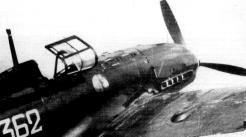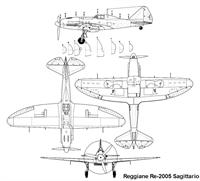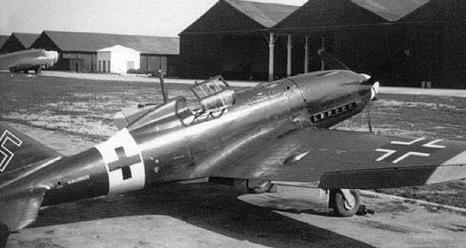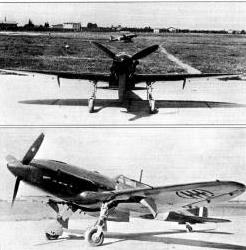




The Reggiane 2005 was the last of the Reggiane aircraft line to be built during World War II. The project which started in 1941 was carried out by a team led by Roberto Longhi with the designers Alessio, Maraschini, Toniolo and Pozzi. Preliminary work was completed before the end of the year despite being a new project and not the development of an existing design such as the Reggiane Re.2002. The DB 605 engine was waiting to be delivered when the airframe was ready in February 1942. The new machine was not only rated as one of the best Axis wartime aircraft but also one of the best, if not the best-looking. Its semi-elliptical wings, long nose and large tail were all distinctive features of this small, nimble fighter.
The prototype MM.494 first flew 9 May 1942 but, the day after, a heavy landing led to an undercarriage failure which caused serious damage, and the aircraft was grounded until June (MM.494 was damaged twice more in tests). This prototype had four Breda 12.7 mm machine guns and one Mauser cannon and was primarily used for testing and then for the aerial defense of Naples. After a fierce competition, in which the C.205N was quickly abandoned and the G.55 was considered better from a production point of view (being only marginally inferior as a fighter but much easier to mass produce), the Regia Aeronautica ordered the production of 750 Re.2005 aircraft, an optimistic figure in wartime Italy.
The Re.2005 was a low-wing, single-engine, single-seat fighter monoplane, made of light alloys. Propulsion was by a 1,475 hp (1,100 kW) Daimler Benz DB.605A-1 engine, either of original German production or built by Fiat as the RA.1050 RC.58 Tifone (Typhoon). The aircraft had a right-handed, three-bladed Piaggio P.2001 constant speed, mechanically controlled, variable-pitch metal propeller. The streamlined but tiny fuselage was almost totally dominated by the DB 605 engine with little room for fuel storage. The fuselage-mounted MG 151/20 cannon had less ammunition than those mounted in the wings (150 rounds versus 170 rounds in the wing gun bays from the second prototype on). The comparable Fiat G.55 had 250 rounds for the fuselage gun but also 600 for a 12.7 mm machine gun. The smaller Re.2005 also carried 100 fewer 20 mm but 100 more 12.7 mm rounds, a lighter armament array.
The aft fuselage was unusually small, even by Italian standards and contained the radio equipment, oxygen bottles and supported the relatively large fin. The cockpit was covered by a canopy which tilted to the right for access and had an armoured 50 mm glass windscreen. Other protection included a seat with 8 mm thick steel shell weighing 40 kg . The seat provided little protection against 12.7 mm rounds which were capable of piercing even 25 mm at short distances but the armour was tempered, giving more protection than homogeneous steel. Given the heavy weight of a thick steel plate, every attempt was made to make the steel alloy used stronger and a headrest was attached to bulkhead six.
The sophisticated wing design, often described as elliptical, was semi-elliptical, with wing thickness tapering from 15 percent at the root to 8 percent at the tip. The structure of the three spars incorporated a "T" section. The triangular-shaped wing and tail control surfaces were mostly fabric-covered, included all-metal two-part split flaps and statically balanced ailerons. Fuel was carried in four self-sealing wing tanks, two forward and two behind, providing a capacity of 525 l . The wide-track undercarriage retracted outwards into the wings and the tailwheel was fully retractable. The Re.2005 was the only Italian aircraft of the war to have hydraulically activated flaps. The Re.2005 was one of the most advanced Italian fighters but it was also too advanced to be made by the Italian industry and one of the most expensive, if not the most expensive to produce. The complexity of the Re.2005 design and small dimensions led to the Fiat G.55, being evaluated as a superior choice for mass production.
The first pilot to use the Re. 2005 in action was Maggiore Vittorio Minguzzi, commander of 22° Gruppo. The unit was based at Napoli-Capodichino airfield for the defense of the city. Minguzzi received the prototype of the Re.2005 (MM.494)—after flight test evaluations in Guidonia—and made the first flight with this aircraft on 7 March 1943. He and the most able pilots in the Gruppo flew this prototype until 23 March and they all had a very favourable and enthusiastic impression of it. He then took it to Napoli-Capodichino where it was incorporated into 362a Squadriglia. This unit—commanded by Capitano Germano La Ferla—was the first to be equipped with the Re.2005.
Minguzzi scrambled for the first time in the Sagittario on 24 March, when Naples was attacked and on 2 April he claimed a four-engined B-24 Liberator bomber over the Isle of Ischia. This claim is not verified against corresponding USAAF losses. Italian ace Vittorio Minguzzi was impressed by this aircraft following its tests and combat debut on 2 April 1943. He wrote
"The aircraft is in ideal flying conditions at an altitude of 7,000–7,500 m and can make repeated attacks on American heavy bombers in all positions and from all directions... I can therefore say that the speed and handling qualities are excellent even at 7,000 m and that compared to the Macchi 202, the Sagittario made two attacks in the time required by the Macchi C.202 for a single pass."
This statement provides a realistic comparison between the two aircraft: in theoretical speed, the Macchi C.202 was only 30 km/h slower but the Re.2005 with the DB-605 engine and larger wing, provided a substantial improvement in performance at high altitude (the difference was less marked at medium-to-low altitudes, as the comparison with the C.205V showed). During April, 362a Squadriglia received three more Re.2005s from the 0-serie but the number of Re.2005s in the 22° Gruppo never exceeded eight.
The first confirmed air victories came on 28 April, when four Re.2005s from 22° Gruppo scrambled (with C.202s and one Dewoitine D.520) from Capodichino to intercept a formation of 30 B-24s Liberators, escorted by 30 fighters heading for Naples. The Re.2005s were flown by Maggiore Minguzzi, Capitano La Ferla, Tenente Giulio Torresi and Sergente Donati. The 22o Gruppo claimed one B-24 (by Minguzzi) and four probables (one was later confirmed by ground observer and credited to Donati). Ten more were claimed as shared damaged by the whole Gruppo.
More aircraft arrived at 362a Squadriglia and in the following weeks, this unit displayed a lot more potency than C.202 units, claiming several bombers for the loss of a pair of Re.2005s. By 25 June 1943, Reggiane Re.2005 pilots claimed a total of seven B-24s and many others damaged but losses claimed seldom matched true losses. At least one Reggiane, MM.092343 of Lt. Moresi, was shot down.
On 2 July 1943, 362a was sent to Sicily to face the imminent invasion and were involved in combat with Spitfires, claiming five shot down from 11 to 14 July (two were confirmed kills: a reconnaissance Spitfire and another downed in a strafing attack over Comiso). Spitfires were formidable opponents (even if many were only Mk Vs), with two Re.2005s destroyed on 11 July and the rest bombed or strafed on the ground. Only two aircraft returned to Sicily.
Ten more fighters joined 362a but when one was damaged in a steep dive on 21 August 1943, some concern was raised. On 25 August, MM.092356 (Lt Dario Signorini bailed out) was lost during another dive and so further flights were discontinued. It was discovered that at speeds over 660 km/h (410 mph) TAS, every manoeuvre could adversely affect the flight control in the tail and then cause damage to the fuselage from flutter. Re.2005 pilots were forbidden from attaining very high speeds (VNE 800 km/h ) but by then, operations were winding down as the Armistice was taking effect. In July 1943 trials, Cmdr. de Prato achieved a speed of 980 km/h in a dive with no loss of control and experienced no flutter.
The production Fiat R.A. 1050 Tifone engines, licensed produced DB 605s, were limited to 2,650 rpm instead of the usual 2,800 rpm with a corresponding drop in power from 1,100 to 1,007 kW (1,475 to 1,350 hp). The MM.494 prototype fitted with a DB 605 had a recorded speed of 678 km/h when flown fully equipped but this speed was attained by levelling the aircraft after a dive. The official maximum speed was 628.5 km/h at an altitude of 6,950 m . The Re.2005 had good handling in dogfights and according to General Minguzzi, who flew both the Re.2005 and the Spitfire, the Re. 2005 was even better than the Spitfire in tight turns and handling.
One of the few examples of combat reports, dated 11 July 1943, seems to contradict Minguzzi's statement, when together with other Italian fighters, Eugenio Salvi's Re.2005 fought against Spitfires over Sicily. A Spitfire Mk V latched onto the tail of Salvi's Re.2005. Salvi tried all the tricks he knew: dives, tight turns and climbs but the Spitfire remained steadily attached to his tail following every move and then opened fire. Salvi's Re.2005 was struck by many bullets and Salvi was sure he was going to be killed when the Spitfire just as suddenly vanished, possibly out of ammunition. Fuel levels and pilots skill probably were the deciding factor in this incident.
On 25 August de Prato carried out test dives at Guidonia. He then flew the aircraft back to Reggio Emilia where three more dives were made on 27, 29 and 31 August. According to De Prato's account, the tests concluded that the "shaking" began at 660 km/h (410 mph) true air speed and that they were caused by inadequate dynamic balancing of the empennage, the balance likely lost during full excursion rudder maneuvers performed during dives. After correcting the balancing, de Prato dived the aircraft to 980 km/h TAS convincing himself that the structure of the Re.2005 was fully capable of high g maneuvers. De Prato wrote, "Our pilots were used to small rudder control surfaces, such those of Macchis and Messerschmitts; with such aircraft full excursion rudder movements were not a problem".
With the armistice on 8 September 1943, some of the few surviving Re.2005s were destroyed by their pilots to prevent them from falling into German hands. Six aircraft were used as trainers by the Aeronautica Nazionale Repubblicana (ANR) the air force of the German allied Italian Social Republic). About thirteen Re.2005s were seized by Germany and some sources have these aircraft in use during late 1943 by the Luftwaffe for air defense against Allied bombing raids over Berlin; others believe that the Re.2005s were used by the Germans in Romania as interceptors over the Ploiești oil fields. Other research indicates that the aircraft probably never left Italy; on 18 March 1944, three aircraft of the Luftdienst Kommando Italien (M.M.096100, 096106, 096110) were severely damaged at Maniago by a U.S. air raid, while at least three others suffered accidents at Maniago (096108: 16 March 1944, 096100: 1 June 1944) and Airasca (19 April 1944) and were returned to Reggiane for repairs. As late as 31 July 1944, five Re.2005 were listed in service with the Flieger Ziel Staffel 20, which operated them from June to December 1944.
The Re.2005 climbed almost as well as the Bf 109G-14 and turned almost as well as the Spitfire Mk IX, having a turn radius of 195 m without full flaps and 148 m with full flap. German tests at the Rechlin test center concluded that the aircraft "curved well, rolled like the Bf 109 G-4 with rudder forces a little less".
Grp Cpt. Duncan Smith, DSO, DFC, a British fighter pilot and fighter leader of World War II, greatly respected the Re.2005,
The Re.2005 'Sagittario' was a potent aircraft. Having had a dog-fight with one of them, I am convinced we would have been hard pressed to cope in our Spitfires operationally, if the Italians or Germans had had a few Squadrons equipped with these aircraft at the beginning of the Sicily campaign or in operations from Malta. Fast, and with excellent manoeuvrability, the Re.2005 was altogether a superb aeroplane. Neither the Macchi 205 nor the Bf 109G measured up to the capabilities of the Re.2005 series in manoeuvrability or rate of climb. I think it was easily the best aircraft Italy produced. It is a pity that no Re.2001/5s survive this day because they were fine examples of Italian engineering craftsmanship
It seems that one of the two Reggiane that had returned to Sicily was captured by the United States Army Air Forces and sent to the US. Little is known of this aircraft, which vanished after the war. While German and some Japanese aircraft were extensively tested, the few captured Italian aircraft (another extant example is a captured Macchi C.202) were not known to be tested, so detailed information about them and their flight characteristics is scarce. Sweden was interested in the Re.2005 (already producing the DB-605 under licence) but the order for 50 airframes was never finalized. Total production included two prototypes used as preproduction aircraft which later saw combat service, 48 series production, three prototypes sent to the Luftwaffe for evaluation and one evaluation aircraft at the factory.
| Type |
Single seat fighter |
| Engine |
1 Fiat RA.1050 R.C.58Tifone with a 3-bladed constant-speed propeller |
| Dimensions |
Length 8,73 m, height 3,15 m , span 11,0 m , wing area 20,4 m2 , airfoil N-38 |
| Weights |
Empty 2600 kg, loaded 3610 kg , max. take off weight |
| Performance |
Max. speed 628 km/h at 6950 m , cruising speed 515 km/h , range 980 km (Internal fuel) 1130 km with a 300 l drop tank 1270 km with 300 l droptank plus 2 x 150 l drop tanks, endurance , service ceiling 11500 m , climb 20 m/sec. |
| Armament |
2 12.7 mm Breda-SAFAT machine guns in upper cowling (350 rpg); 1 x 20 mm MG 151 cannon firing through propeller hub (150 rpg); 2 20 mm MG 151 cannon in wings (200 rpg) Bombs: Underfuselage (non standard) hardpoint 1,000 kg bomb or 1 x 300 I drop tank Hardpoints on wings: 160 kg bombs or 2 150 litres drop tanks |




